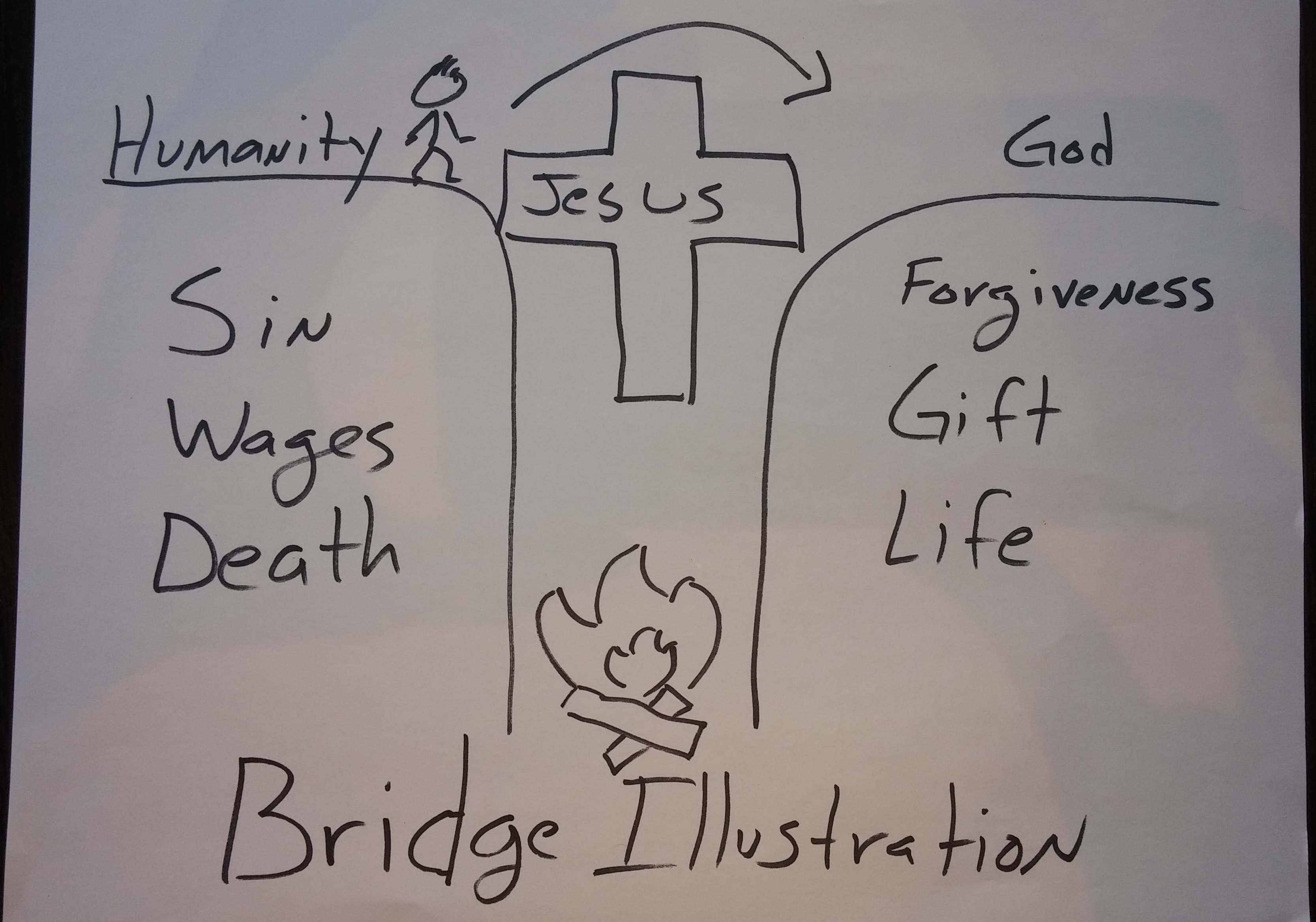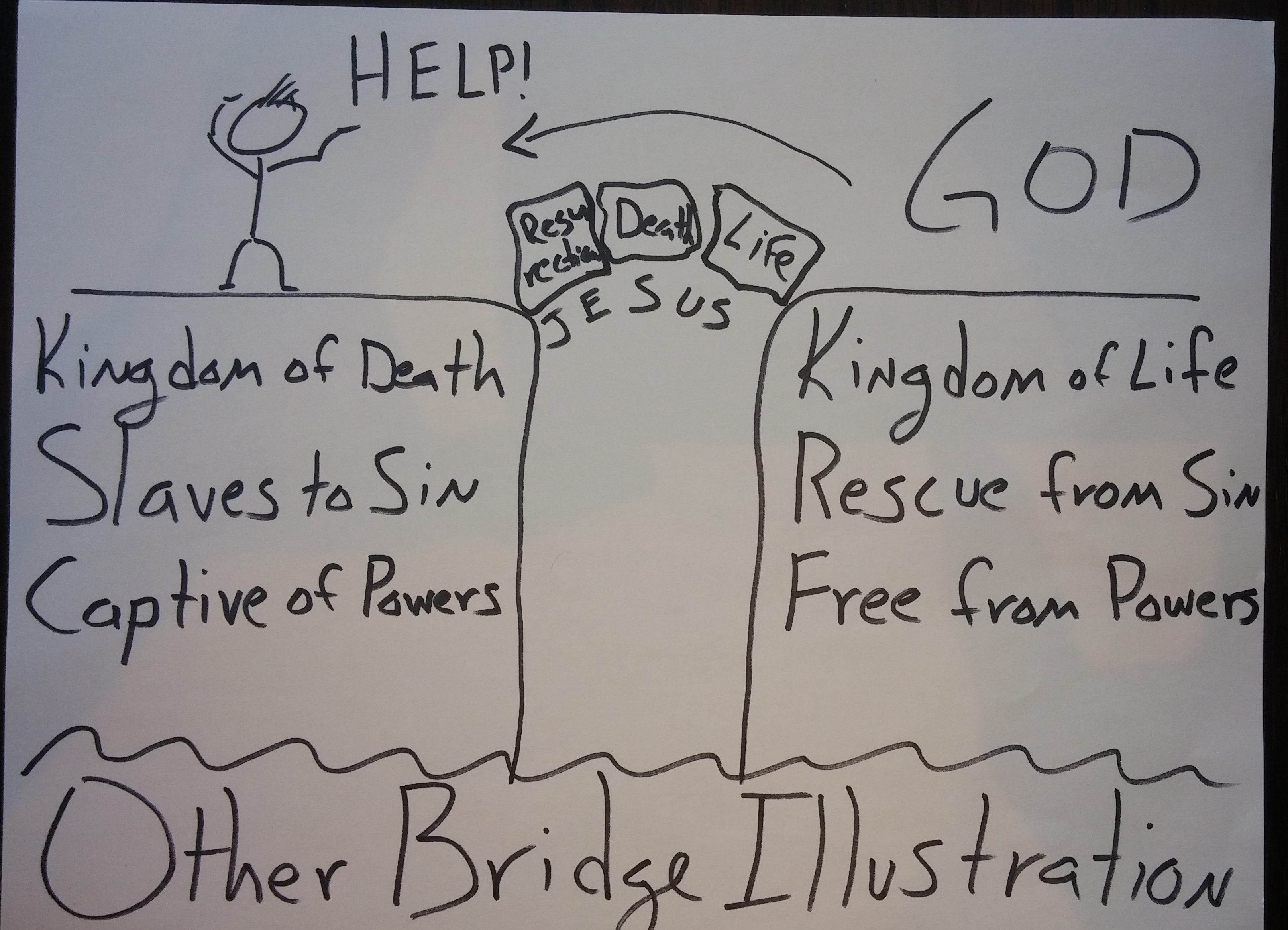For all those visual learners who need to see it to understand it. This is the “Other Bridge Illustration.” And yes, I drew these while at Starbucks.
(David Fitch and I did an entire podcast on this topic if you are interested.)
The Original Bridge Illustration
But first we must talk about the Original Bridge Illustration, that staple of evangelism in my corner of evangelicalism.

This is how I was taught to explain it.
On one side is humanity. Humanity sins (Rom. 3:23). And the wages of sin—what you earn—is death (Rom. 6:23). So “sin”, “wages”, and “death” mark the cliff separating humanity from God.
But on God’s side, God chooses to forgive our sin, which is a gift of grace—not earned like wages. And this gift leads to life (Rom. 6:23). So “forgiveness”, “gift”, and “life” are on God’s side.
The death of Jesus—his cross—becomes the bridge by which we cross over from sin and death and receive forgiveness and life.
We cross over to God through the cross of Jesus.
Simple, right?
Problems with this Bridge Illustration
Often—but not always—this presentation of salvation emphasizes individual sin and individual responsibility and individual salvation (notice a theme?). It also assumes a movement from the side of humanity (on “earth”) to God’s side (in “heaven”).
Also, this view, when unpacked, usually holds to certain understandings of God’s wrath against humanity and how Jesus’s death satisfies God’s wrath so that we can avoid hell fire (drawn at the bottom of the chasm—too bad I didn’t have a red sharpie).
And lastly, this view can lead to truncated understanding that “Jesus came to die” or “Jesus was born to die“—which I regularly hear on Facebook or Twitter when I emphasize the significance of Jesus’s ministry or the kingdom of God.
The Other Bridge Illustration
But humanity IS separated from God.
Something needs to be done.
We need salvation.
So here is the Other Bridge Illustration.

On one side is humanity. We are within the kingdom (or reign) of death (Rom. 5:14-17). We are slaves to sin (Rom. 6:17). And we are captives of the powers (Col. 1:13).
But on God’s side is the kingdom of life, the redemption from sin, and liberation from the powers.
The bridge is made of three stones—the life, death, and resurrection of Jesus (I don’t know why stones. It’s just what came to me).
God coming to us.
But here is the main twist.
Through the life, death, and resurrection of Jesus, God is coming to us.
God comes from heaven to earth. God comes to the damned and the sinners. God comes to the enslaved and captives. God comes to seek and save the lost.
The totality of Jesus’s life, death, and resurrection witnesses to this.
Salvation comes to where we are. And this has always been the case. From Genesis to Revelation, God seeks to dwell with humanity. And God is pursuing humanity, bridging every divide, overcoming every obstacle.
This is the victory of God—not that we leave the place of sin and death, but that God overcomes by coming to our place of need, of desperation, of death.
Both/And…ish
To be fair, parts of the Original Bridge Illustration are true and we shouldn’t ignore them. But we must place them in the larger context of the Other Bridge Illustration—The Christus Victor Illustration.
What needs to be added?
What would you add to make this better?
(I want to figure out the best was to add the Holy Spirit to this illustration.)


11 replies on “The Other Bridge Illustration: Visual Christus Victor”
Excellent! Love it. Like all things human it can’t cover or relate perfectly to that which is holy. As is it’s wonderful and useful. It has me raising a couple of questions concerning “death.” C.V. Atonement tends to be a little more heavy on the issue of Christ undoing, conquering, defeating death itself. You bridge is lite in that regard for me. But I have no suggestion as to how to make it better.
Yeah, you are right. The whole “death defeating death” would probably need some animation. LOL.
It’s too static. Both the original and yours only have one panel. Don’t let that confine you. Turn it into a multi-panel story and show how there’s movement, maturity, and depth in a process of transformation.
You can address that by talking as you draw.
Very good. Very usable.
The question is always a diagnosis of the basic problem of humanity. The Bible says 4 things are wrong. Dead, rebels, that are guilty, and have lost our identity and inheritance. 4 answers. Regeneration, conversation, justification, adoption.
I think the fundamental error of many is to assume there is only one way to view the atonement. We want to have a flat theory that eliminates all paradox and tension from the equation. If ransom then not satisfaction. If kingdom come on earth as in heaven then no heaven or hell. If universal atonement then universalism. If salvation by grace, works aren’t essential. We love to eliminate mystery from our thinking and I believe it is deadly. I like ransom theory very much and love your illustration. Both drawings seem truthful to me. I don’t see the satisfaction of divine wrath as something causing massive problems unless it is used as a bludgeon against all other ways God was acting in the atonement. Why assume God was doing one thing? Just my thoughts on a rainy Sunday Morning. Thanks!
Thanks Lewis. Yes I long to life into the mystery also. I appreciate the comment.
Love this! I wonder, could the diagram show Christ entering the scene on the left side with humanity (life/incarnation)? In his dying, Christ goes down into the chasm (dies our death). Then in his resurrection, Christ defeats death and ascends to the Father. Christ is then able to lead us through this new path that’s been forged. I think this would open up a lot in showing Christ’s solidarity with humanity, our unification with Christ in salvation, the reliance of Christ on the Holy Spirit in his life, death, and resurrection, Christ as the second Adam/first fruit of the new creation, disarmer/overcomer of death, etc.
[…] it is the penal substitutionary or the Christus Victor view, sin so often that takes center […]
Late to the party here, but this was linked from the You Have Permission Patreon page on FB.
WRT the destruction (death) of death, I love the image of Christ storming the gates of hell. That may not fit with Christus Victor (Is humanity in hell? What does hell mean in scripture?), but it certainly goes to the idea of Christ’s victory. Having grown up Reformed with a strong dose of ECT and PSA (Eternal Conscious Torment and Penal Substitutionary Atonement), it’s only been in the last five years or so that I learned about CV via the gospel in chairs illustration (https://www.youtube.com/watch?v=Wnj52gaauBs). It’s really helped me to change my view of God as distant and angry to immanent and loving. I knew that intellectually before, but now I’m beginning to feel it.